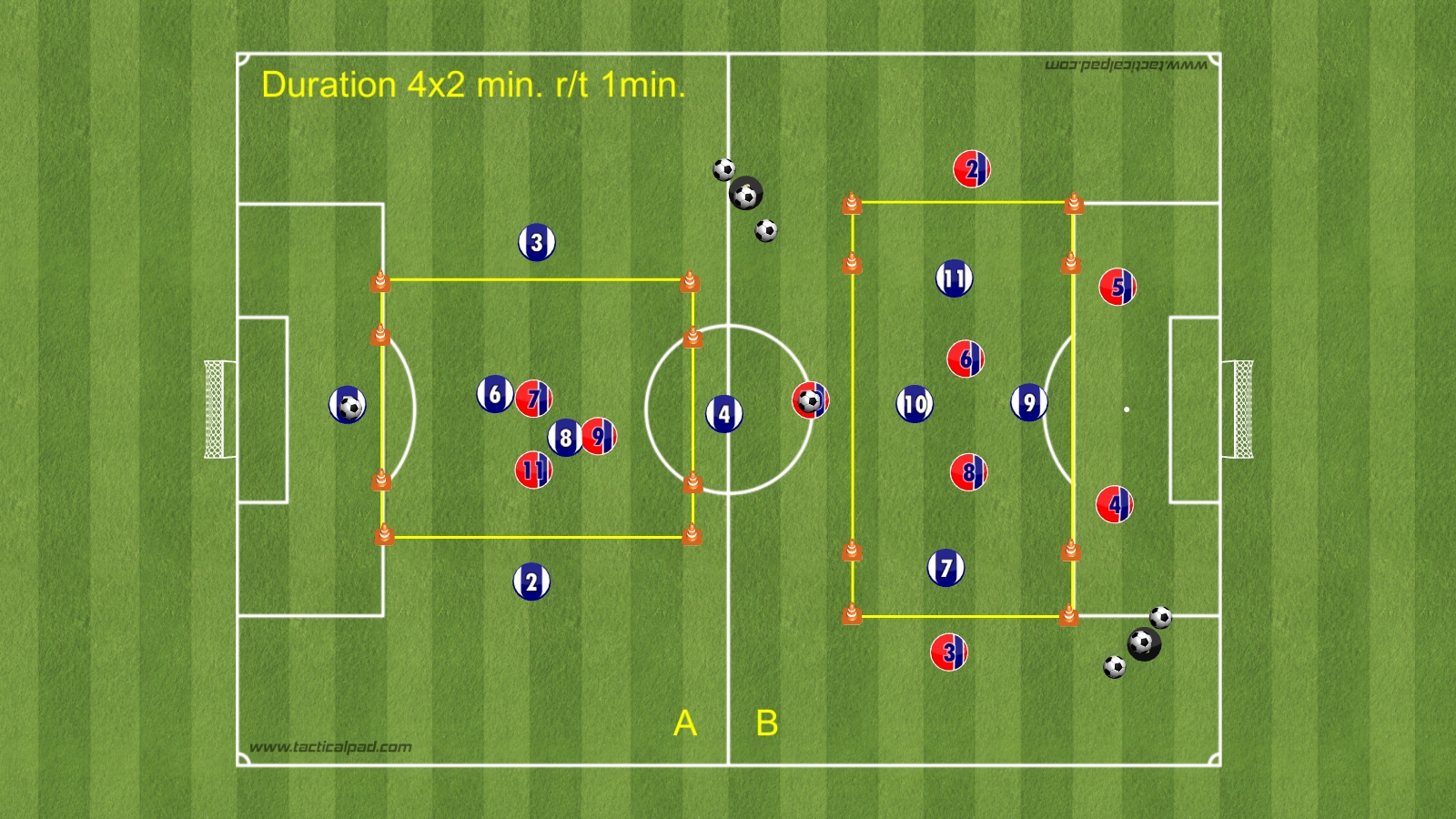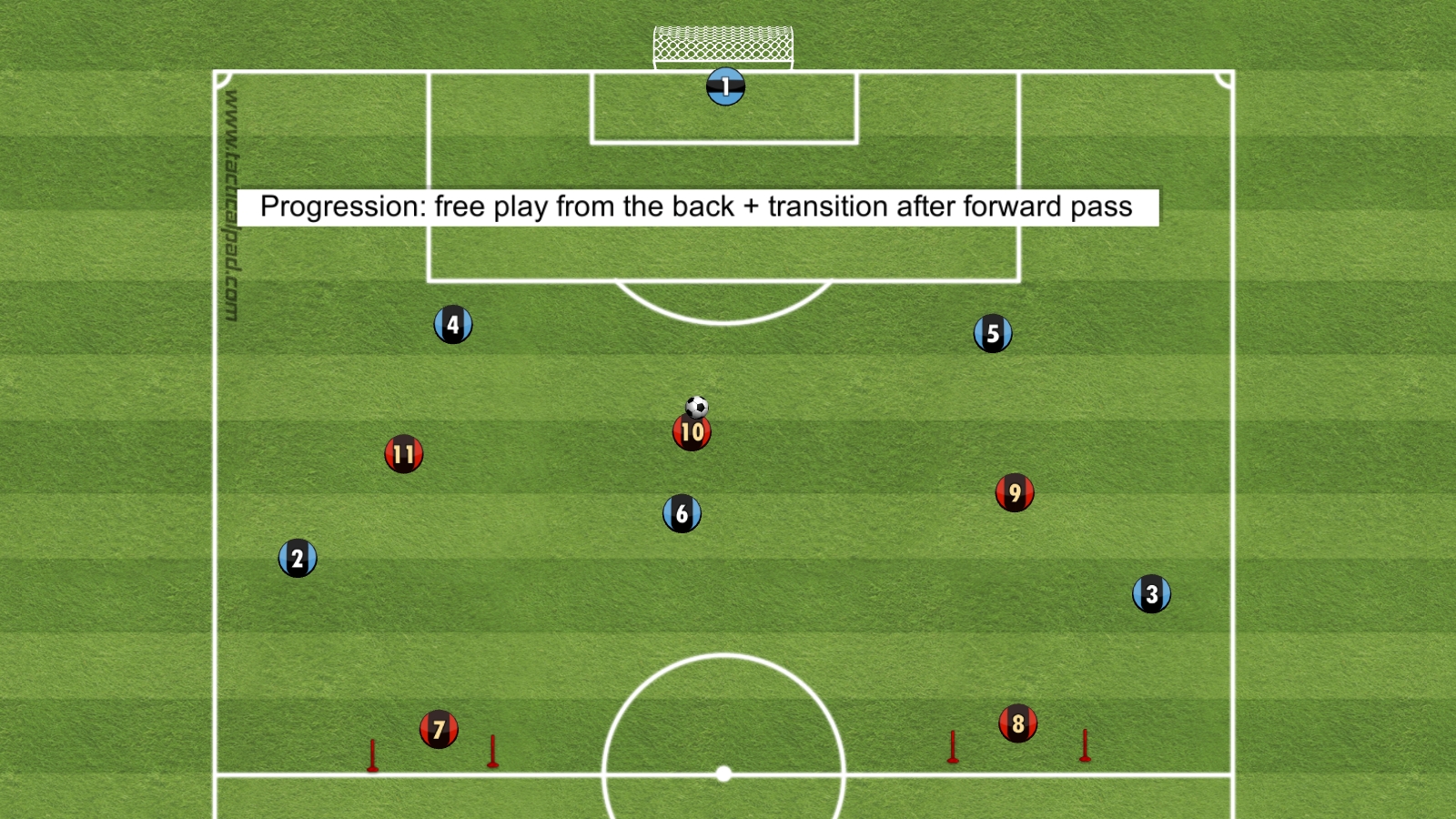WARM UP
As the ball is passed in the passing player presses the receiving player who now has a 1v2 to goal. if the defender wins the ball they can attack the opposite goals.
Progression could be to add a supporting attacker
December 23, 2024
WARM UP
Ball is played wide to the full back who opens up to play the winger, when the winger receives the ball he bounces it back which is the trigger for the striker to come and look for the pass through the lines, from there the winger makes a wide run to receive the strikers round the corner pass and go on to finish on goal.
Work both sides, players move up 1 position on rotation
December 23, 2024
ESERCIZIO INTEGRATO 3.7.2019
ESERCITAZIONE INTEGRATA
Nella presente esercitazione abbiamo 3 squadre composte da 4 elementi ciascuna , ed un campo a ridosso dell’area di rigore suddiviso in due Settori (A e B) .
Delle 3 squadre la prima (i neri nel video disposti a coppie) ha come compito quello di eseguire dei cross in area di rigore (alternativamente da sinistra e da destra) dove il giocatore della parte opposta deve cercare di anticipare il portiere in uscita : all’interno dell’area saranno posizionate delle sagome.
La seconda squadra (i blu nel video) ha i 4 elementi disposti nel campo di cui 3 nel Settore A ed 1 nel Settore B : questi 4 elementi dovranno attendere i giocatori rossi (terza squadra) i quali, dopo essere partiti in coppia (1 da dx ed 1 da sx) ed aver eseguito dei cambi di direzione tra i coni, affronteranno la squadra blu all’interno del Settore A in una situazione di 4vs2 (un giocatore blu agisce come sponda esterna restando nel Settore B).
Obiettivo per la squadra blu sarà quello di segnare nella porticina , mentre obiettivo della squadra rossa sarà quello del recupero della palla che consentirà di attivare un 2vs1 nel Settore B contro il giocatore blu, con lo scopo di uscire dal Settore, entrare in area e concludere a rete. Alla fine del situazionale 2vs1 i giocatori eseguiranno un esercizio a navetta fra i coni prima di rientrare sulla posizione iniziale con successiva partenza della seconda coppia di elementi rossi.
Ruotare le squadre nelle posizioni.
December 23, 2024
Learning and context: an indivisible combination

This is called “Context Dependent Memory”. There are numerous studies in the second half of the 1900s that attempted to demonstrate how the characteristics of the context in which learning takes place influence the ability to memorize and recall that specific learning.
THE EXPERIMENT
Among the many experiments that are developed in order to demonstrate this important characteristic of human memory, the one by Godden and Baddeley in 1975, published in the British Journal of Psychology, is very interesting.
The two authors use a simple task (studying and remembering a list of words) experimenting with the effect of context thanks to the use of two very different environments. The subjects of the study, members of a university diving club, are divided into two groups: one of them practices the study of this list of words on land, while the other group does it underwater. At the end of the learning period (the two groups study the same number of words for the same period of time) the test takes place.
To investigate the effect of context on memory, the groups are divided into two subgroups. The group that studied on land is divided into two, one part will be questioned on land while the other part underwater. The same procedure is carried out for the group that studied underwater, half are questioned in the same study environment while the other half on land.
How many words will they remember?
As can be seen from the graph below, the influence of the context is not only present but is absolutely significant and affects the subjects' memory. Those who have studied on land and are questioned underwater, as well as those who have studied underwater and are questioned on land, remember many fewer words than the other half of the group, who are questioned in the same learning environment. 
CONCLUSION
Some authors (Williams H. Edwards et al) define it as ENCODING SPECIFICITY PRINCIPLE. The characteristics of the context in which we learn something influence the degree of our learning. How? When we learn something we not only memorize the explicit, i.e. the content of the learning that we consciously internalize, but also the implicit, i.e. the characteristics of the context (light, temperature, interpersonal spaces, speed of movement, etc.) that we learn unconsciously. They are like "the canvas on which an artist paints", we may not realize it but they form the substrate on which we store all the explicit memories that we intend to learn.
The more similar the characteristics of the training context are to those of the competition, the greater the effect of practice will be, and consequently the degree of learning. The transferability of learning depends on the fidelity of the characteristics of the context in which this learning is developed.
TEAM SPORTS
If in individual sports, especially the so-called "closed skills" (see athletics), respecting this principle can all in all be simple and natural, things can change quite a bit when we instead consider training within sports of situation.
Let's take the example of a goalkeeper, in football but also in hockey, or handball, who in order to be trained more on saving is subjected to a continuous series of shots by his coach. How many of these shots can we consider “real”? How much will the diversity of the context (think of spaces, opponents, companions, psychological and temporal pressures) influence the transferability of this learning and consequently the effectiveness of this practice?
Differential Learning
Emergent behavior
Emotionality of disorder
Order in game ideas
The power of the question
Back to technique
Stop post-covid socio-psycho-motor learning
Disorder in the context of training
Randomized targets
Think in tasks and not in roles
Relationship and relationship between footballers
Fluid space
Part 1:
Part 2:
![]() Be open to new teaching perspectives , explore new operational scenarios, continually search for the unexplored, the unexpected, the removed.
Be open to new teaching perspectives , explore new operational scenarios, continually search for the unexplored, the unexpected, the removed.
This is the founding meeting of a group of 'extraordinary' trainers who will guide us through a training path created to take up the challenge of the unpredictability of the game and its learning.
![]() There couldn't have been a different beginning ...
There couldn't have been a different beginning ...
Today we present the first training environment of Alessandro Vittorio Formisano and his team "The non-linearity of learning in the game of football".
![]() Together with Emanuele Tedoldi, Javier De La Guardia, Pasquale Pastore, Stefano Zerbato and Tommy Dal Santo will be a journey into the game, through its complexity to reach the new evolutionary stages of learning.
Together with Emanuele Tedoldi, Javier De La Guardia, Pasquale Pastore, Stefano Zerbato and Tommy Dal Santo will be a journey into the game, through its complexity to reach the new evolutionary stages of learning.
We will do it together without filters, step by step.
![]() Ideas and constant comparison to grow and build a road that leads us towards a change of paradigm, away from everything that tries to change the complexity of the game.
Ideas and constant comparison to grow and build a road that leads us towards a change of paradigm, away from everything that tries to change the complexity of the game.
You can watch the introductory seminars for free, don't miss this opportunity... start now!
RONDO GAMES
Set Up: Pitch A-30x20m; B-35x45m; balls; cones ...
Organization: In the field A we have numerical superiority rondo game 2+4vs3, with four external players / on the cross lines between the gates and on the side lines. Blue players play possesion game. Red players task is to take away the ball and score points by organizing quick action and pass the ball tgrough the one of the four gates. When the red players get the ball, the task of the blue players inside the field is as quickly as possible to make a re-possesion with the help of players from te side lines who entering the field of play to re-possesion.
Coaching points: Development stereotypes of cooperation between back row players and two central midfielders.
In the field B we have numerical inferiority rondo game 2+5vs4, with same requirements.
Coaching points: Development stereotypes of cooperation between offensive oriented players in degradation of attacks.
December 23, 2024



